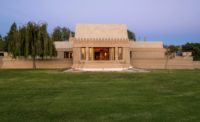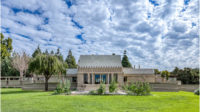Artist Intervention at Frank Lloyd Wright's Hollyhock House Reanimates Tensions of Historic Project’s Construction

Entanglements, on view through May 27th, is the first-ever artist intervention at Frank Lloyd Wright's Hollyhock House in East Hollywood, Los Angeles. Photo © Joshua White
A collaboration between two people can often become a source of tension long after it is said to have been resolved.
What began in 1919, for instance, as a venture between Frank Lloyd Wright and his client, the oil heiress Aline Barnsdall, to design a 36-acre arts compound within a hilltop olive grove in the East Hollywood neighborhood of Los Angeles ended on famously poor terms when construction ceased two years later. Wright sought control over virtually every element of the client’s residence at the center of the property, so the story goes, while Barnsdall, an outspoken independent feminist and devotee of experimental theater, was determined to incorporate flashes of her own personality into the property.

Exterior view of the Hollyhock House, 1921. Photo by Julius Shulman, courtesy Getty Research Institute
The result—now known as the Hollyhock House, the only building in Los Angeles inscribed on the UNESCO World Heritage List—was a sprawling, occasionally austere architectural work punctuated by eclectic decor begrudgingly approved by the architect: a cloth chandelier, a rattan chair with a floral cushion, and a 1st-century Roman relief propped up on two Wright-designed tables, to name a few. The final product left Barnsdall so displeased that, in 1927, she donated her residence and a portion of the land to the city. Perched on a crest above Hollywood Boulevard, the site has served as a park and vibrant community cultural center known as Barnsdall Art Park ever since.
In Entanglements, the first site-specific artistic intervention within Hollyhock House, local wife-and-husband artists Louise Bonnet and Adam Silverman effectively draw from the conflict that went into the creation of the home more than a century ago while remaining in easy dialogue with the rich color palette of its sumptuous interior. “This building has been a regular presence in our life since we both moved to Los Angeles,” Bonnet told RECORD at the site, which is located between the artists’ home in Silver Lake and their studio in Atwater Village. “As our first collaborative project, we wanted to create our pieces separately so that they could come together in the space as a dialogue that we couldn’t predict.”


Photos © Joshua White
In an alcove of the living room, Bonnet’s large-scale portrait of disembodied hands, resting atop a crumpled cloth in the same wood tones as the room itself, appear to be embracing so tightly that they seem to be strangling each other. Silverman’s conjoined vessels, located in front of Bonnet’s portrait, conjure the same sense of unease as a fragile balancing act rendered in clay and the ashes of wood sourced from the surrounding olive grove. In the book-lined study, a smaller version of Bonnet’s enclasping hands is seen clutching a piece of paper, “perhaps one of the exorbitant bills passed between Wright and Barnsdall,” Abbey Chamberlain Brach, Hollyhock House curator with the City of Los Angeles Department of Cultural Affairs, posited during the press preview. Silverman’s ceramics, meanwhile, can be found in nearly every room carrying on quiet conversations with other objects in the space that have taken residence for decades.
Though collaboration can often be a tricky back-and-forth to navigate—whether that is between an architect and a client or a husband and a wife—Entanglements masterfully demonstrates that, so long as all members are passionate, it can lead to the creation of new forms of expression.
Entanglements is on view now at the Hollyhock House at Barnsdall Art Park through May 27. The site is open to the public Thursday–Saturday, 11 a.m. to 4.p.m. Advance ticketing is required.


